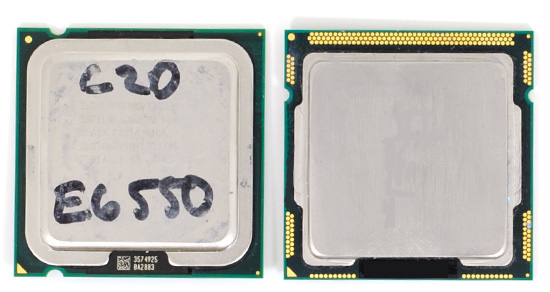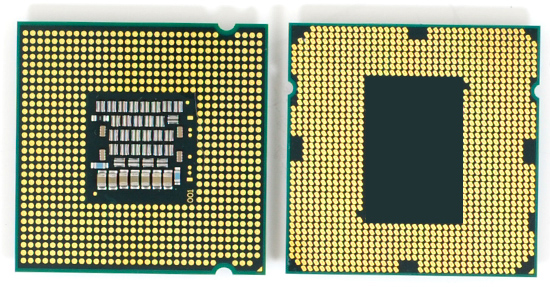The Lynnfield Preview: Rumblings of Revenge
by Anand Lal Shimpi on May 29, 2009 1:00 PM EST- Posted in
- CPUs
The First Lynnfield Sample
Let me preface this with the usual disclaimer. Intel did *not* supply me with this chip and it is most definitely pre-production silicon, not necessarily indicative of final, shipping performance.
With that out of the way, here is Lynnfield:

Lynnfield (front) vs. Bloomfield (back)

Core i7-Bloomfield (left) vs. Lynnfield (right)
It’s a lot smaller than the LGA-1366 Core i7, but compared to current Core 2 Quads it’s actually similar in size:

LGA-775 Core 2 Duo (left) vs. LGA-1156 Lynnfield (right)
Flipping the chips over you see that Lynnfield has a much higher pad density, enabling Intel to fit 1156 pads in about the same space as it fit 775 pads just a few years prior.

Core 2 (left) vs. Lynnfield (right)
Once more, I’ve blanked out all of the caps and other markings on the chip to protect the innocent.
The initial Lynnfield samples were all clocked at 2.13GHz with HT enabled. Turbo mode was also enabled but it too was a meager 2.26GHz regardless of how many cores were active. All of this was to enable motherboard manufacturers to test compatibility and performance of their P55 without giving away Lynnfield’s true performance.
Unfortunately this is the sample I tested with. Thankfully it was healthy enough for me to overclock the BLCK to 166MHz, resulting in a 2.66GHz frequency. Turbo mode was still stuck at a 1x increase over the stock frequency, so final Lynnfield performance should be much better in single and dual threaded apps than what you’ll see here today.
The results on the coming pages show three configurations. Lynnfield running at 2.13GHz with HT enabled, 2.66GHz with HT enabled and 2.66GHz with HT disabled. The latter is going to be the closest to actual Lynnfield performance (albeit still far away thanks the sample’s crippled turbo mode), the 2.66GHz with HT enabled just shows how much we gain from HT and the 2.13GHz chip is an experiment in seeing how low Intel could drop these things and still have a competitive part.
If you thought Nehalem needed Hyper Threading to be a strong performer, you were dead wrong.
Comments About Lynnfield's Readiness
The current rumors in the press are that Lynnfield is being held back in order to clear out excess Core 2 Quad inventory before it ships, because once this thing ships no one is going to want a Penryn anymore. Based on what I've seen, Lynnfield isn't ready just yet - it's not an artificial delay.
The motherboards are in rough shape, CF/SLI isn't working and we're still at very early revs of the CPU's silicon. While I think that the chip will be ready far in advance of its rumored September shipdate, the CPU and motherboards aren't yet.
The Test
Once more: the CPU we've tested here is pre-production silicon without all of its turbo modes enabled. I expect final, shipping performance to be higher in some cases.
| Motherboard: | Pre-release P55 Motherboard (Intel P55) Intel DX58SO (Intel X58) Gigabyte GA-MA790FX-UD5P (AMD 790FX) |
| Chipset: | Intel P55 |
| Chipset Drivers: | Intel 9.1.1.1012 (Intel) AMD Catalyst 8.12 |
| Hard Disk: | Intel X25-M SSD (80GB) |
| Memory: | Qimonda DDR3-1066 4 x 1GB (7-7-7-20) Corsair DDR3-1333 2 x 2GB (7-7-7-20) |
| Video Card: | eVGA GeForce GTX 280 |
| Video Drivers: | NVIDIA ForceWare 180.43 (Vista64) NVIDIA ForceWare 178.24 (Vista32) |
| Desktop Resolution: | 1920 x 1200 |
| OS: | Windows Vista Ultimate 32-bit (for SYSMark) Windows Vista Ultimate 64-bit |










95 Comments
View All Comments
fpaat - Tuesday, August 4, 2009 - link
Cheap as*es who keep buying these lower spec broken underclocked BS parts contribute to the decline of PC gaming.There is exactly zero reasons to release so many different chips, except for crap manufacturing.
Buy an i7, be done. i5 = celeron = piss off Intel. ATI and NVIDIA can piss off as well for release 10 different versions of video cards per generation.
fpaat - Tuesday, August 4, 2009 - link
I LoL at people who still buy the "celeron" equivalent of computer parts.It's fine if your a teenager on a budget, but if you're an adult still buying gimp'd parts because you can't afford proper components, well, fail.
grimpr - Thursday, July 16, 2009 - link
Smart users would simply buy a fast SSD disk and a Windows 7 Home premium 64bit pack. Anand may glorify to heavens Lynnfield i5 but there is not a single excuse for dumping perfectly good hardware from 2006 upward for Intels new mainstream platform. Best upgrade would be in 2011 with a brand new platform from AMD, new CPU's from both companys that carry the AVX instruction sets, cheap low latency and fast DDR3-1600 ram as a standard, mature,cheap and fast DX11 cards, PCI-EX 3.0 and many more things.Hrel - Saturday, June 6, 2009 - link
I HATE their stupid price fixing screw the consumer crap. CPU's over 200 dollars are useless, that's simply too much for a CPU. They won't give us dual cores based on nahaylem cause they'd have to charge 190 and less; OH NO! Greedy bastards. I REALLY want AMD to get back on top so prices get driven down again.It's INFINETELY infuriating that the ONLY way that intel charges fair prices is if someone else MAKES them.
Hrel - Saturday, June 6, 2009 - link
Seriously??? E8400 anyone? I REALLY don't care about having 8 threads, like even you said in this article, doesn't really help consumers. I'm far more interested in highly clocked dual cores, and wish Intel would release dual core CPU's based on the new architexture, throw HT onto a solid dual core and I can't see any games in the near future even fully utilize it.I'd MUCH rather see a 4GHz dual core cpu with HT than some more stupid quad cores at sub 3GHZ clock speeds. This is 2009, we need to leave the sub-3GHz range in the history books.HexiumVII - Tuesday, June 2, 2009 - link
Lynnfield looks mighty good. Unfortunetly USB3 and SATA3 are looming. Since they won't be integrated into mobos for a while, high bandwidth on the PCIe slots for add-in cards will be crucial for the transition. I don't know about you buys, but USB3.0 will be the most exciting upgrade we had in a while.MasterShogo - Monday, June 1, 2009 - link
I'm not really sure if this has been talked about at all, but it seems to me that the option for an Nvidia-supplied chipset providing integrated graphics, and it still be good, isn't completely lost.I think you have to ask, why does a person want Nvidia integrated graphics in the first place? I see two reasons. For one, to provide a "business-like" or super-simple PC that has adequate graphics performance for normal stuff and simple games, but with a powerful processor. For this use, Nvidia could just make a chip that uses 8 of the PCIe lanes coming out of the CPU socket and leave the other 8 for the user/vendor to optionally provide a faster video card. Sure, that slot wouldn't have the awesomeness of a 16x PCIe slot, but it would be perfectly fine for this machine. Plus, the added video card could still use hybrid SLI or something similar for power-saving purposes...
Which leads me to the other reason people (like me) might want it. Power savings via hybrid-SLI. I would personally want all 16 lanes coming out of the CPU socket for my SLI setup or just one monster card. But in this case, I think it would be perfectly fine to have a 3rd party P55-like chip provide hybrid-SLI video for power savings. I wouldn't care about the starved DMI link, because I would never expect that video chip to do anything difficult, that's what I have the other video cards for! This is assuming the drivers work well enough to switch over very seamlessly when it needs to happen.
In other words, I think there is still enough input/output throughput for Nvidia to sell chips that use integrated graphics, but it is just going to be more spread over the board now, making their electrical design more difficult. Possibly requiring two different chips to provide for the two different scenarios. I don't see why they couldn't do it, though.
Or even better, make a 3rd party chip that can accept, as an interface, both the DMI and the PCI links coming out of the socket, but only using what is available in the particular board you are manufacturing at the moment. Maybe that would be too expensive, though. Any thoughts on how feasible that may be?
In any case, I don't need the three memory channels. It's not that I don't WANT them, it's that they don't help me at all. It's not like I'm running a major database server in my bedroom or anything. But having a direct PCI connection to the CPU would be cool, and I think this processor is just super-duper for a variety of reasons.
Kreed - Monday, June 1, 2009 - link
In terms of Photoshop CS4 performance, would a 2.8GHz i5 outperform 2.66GHz i7 920?Beno - Sunday, May 31, 2009 - link
if you test the i7 920 with HT off, lynfield will lose number 1 in those gaming benchmarkswhy didnt you bench it without HT?
genkk - Sunday, May 31, 2009 - link
is there any new mobos like the dragon platform to bench, anad is even using an old catalyst driver......... your 65% chipzilla and 35% chimpzilla